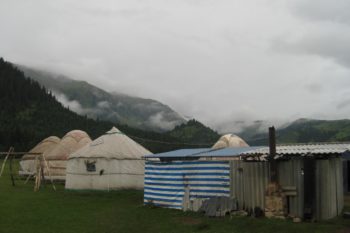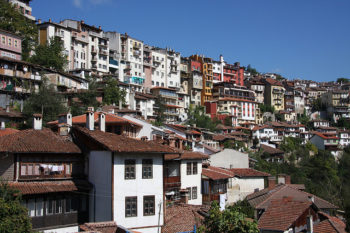Elnura Osmonalieva’s “Almaz” is the first full-length documentary filmed in Kyrgyzstan in the past fifteen years. Directed of “Almaz” by an alumnus of the American University of Central Asia, the film has already gained festival success and has been recognized for the depth and complexity of the topic.
Critics and sociologists believe this film is not just about one character, but about Kyrgyzstan as a whole. Cinema critic Gulbara Tolomusheva drew an interesting parallel between “Almaz” and our country: the same age, 19 years, the same background, and the same dramatic twists and turns. According to her, this film is a microcosm – a private story about the fate of an entire country.
Award winning director
The director’s previous film, “Diamond”, won several film festival awards over a short period, including “Best Nonfiction Feature Film” at the International Film Festival “Altyn Shaken” (Almaty, May 2010), the diploma of the Jury III at the All-Russian Open Festival of Documentary Film “Salt of the Earth” (September 2010), the diploma of the Jury “For contribution to raising human rights issues” at the International Documentary Film Festival “Bir Duyno” (September 2010) and the Grand Prix Festival III for graduates of master classes Ernest Abdyjaparov (November 2010).
Kyrgyzstan’s working children
The movie “Almaz” is the life story of a teenager whose family moves from Naryn to Bishkek in search of better lives. Almaz’s family soon has to earn their living in Dordoi market. Almaz is very young, but he has to work, forgetting about his schoolwork.
Elnura Osmonalieva says she was afraid to shoot another film on working children. In fact, the hero of the film “Diamond” is no exception. The children of migrant workers are often forced to work in the markets so the family can support themselves. The number of working children, as well as the number of labor migrants in Kyrgyzstan, increases every year.
According to statistics from the Ministry of Labor, Employment, and Migration, there were 983 working children in Kyrgyzstan in 2009.
Sociologists point out the difficulty of preventing child labor because of the cheapness in hiring children. Due to this, employers often violate the law and force children to work, which in turn leads to the development of a shadow economy.
A rare happy ending
After a while, Almaz is diagnosed with tumor. With the help of talented doctors and, perhaps, a miracle, he manages to recover. Such an outcome is less than is typical for the majority of working children. According to the analysis of the Ministry of Labour, Employment and Migration, the use of child labor leads to deterioration in child health and reduces the level of education, which subsequently affects the gene pool of the nation and the country’s economic growth.
At a press conference on March 4th, 2010, Burul Makenbaeva, the Director of the Public Association “Mental Health and Society”, reported that in Kyrgyzstan approximately 45 children are diagnosed with cancer annually.
According to her, most children are aged 1-16. “Currently, about 400 children are treated,” noted Burul Makenbaeva. Causes of the disease are the lack of hygiene, poor nutrition, and poverty.
Not enough jobs
According to statistics, the poverty rate in Kyrgyzstan was 31.7 percent at the end of 2009. The main reason for high levels of poverty among youth is a decline in employment in the country and an increase in the employed population. Annually, according to expert estimates, 60-75,000 young people enter the workforce, while approximately 110,000 jobs are created annually, more than 70 percent of which occur in temporary jobs are created mainly in agriculture. The number of new permanent jobs will be approximately 15-30,000 a year, thus the labor market cannot absorb new labor force.
Finding a way out
After an illness, Almaz stops working and starts to spend more time studying the English language. He is engaged in a center for child support in the Dordoi market. Such a center exists also in the Osh market.
According to the founders, in 2009, the Center had taken 124 children. For the last five years, about 500 children were provided with economic and social assistance.
In 2009, Almaz succeeds in his studies and is among ten students who won a trip to Holland. The lemonade salesman and bottle collector discovers another world.
During the trip, Almaz understands the true meaning of life. He understands how important it is to overcome poverty, not only for his family, but also for society as a whole. In the movie “Diamond”, the main character was also aware of the importance of education and continues his training. In that film, children from the families of migrant workers can get secondary education. In 2010, the Ministry of Labor, Employment and Migration, in cooperation with local authorities, conducted the August census of school-aged children. According to the census, they found more than 1,000 children who are not involved in any training or education.
Almaz, the hero of this movie, is now 19 years old. He lives in a new Dordoi district, working and preparing to enter the American University in Central Asia.
According to the director, the moral of the story was not a trip to Europe, but awareness of the opportunities out of difficult situations.
“In the history of the Diamond had a lot of heavy information, so I had to tell the story in such a way so that it doesn’t pull the viewer down, but lifts him up,” added Elnura Osmonalieva.
Nargiza will be back next week in two weeks with a second post on Kyrgyz cinema.
Read more:
Twelve reasons to love Kyrgyzstan
Street fashion in Bishkek and Vancouver
Kyrgyzstan’s resurgance in traditional healing





